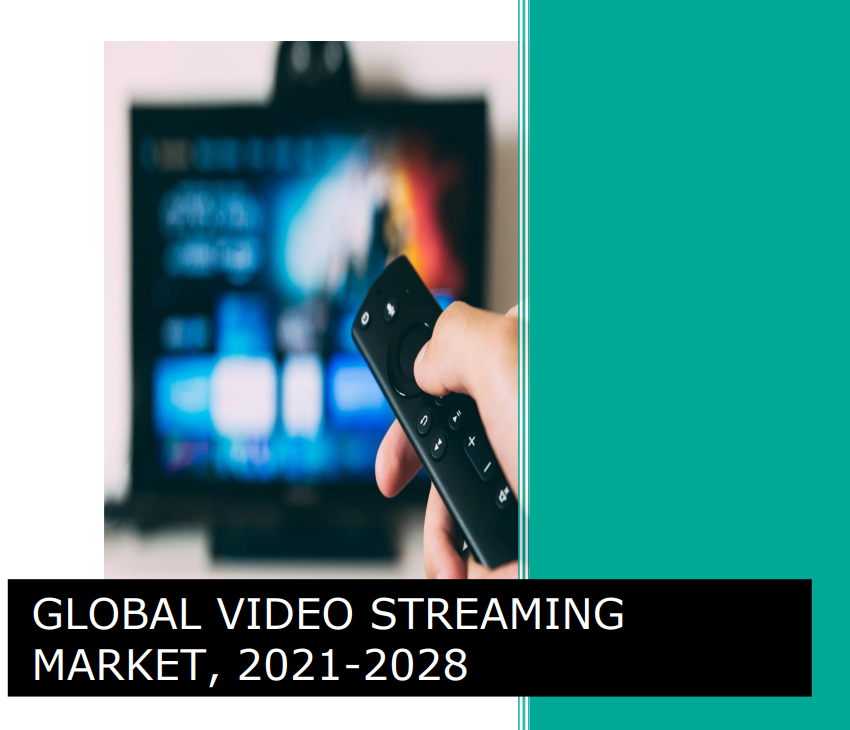Introducing Single Price Syndicate Report

GLOBAL VIDEO STREAMING MARKET
MARKET ANALYSIS & SEGMENT FORECAST FROM 2021 TO 2028Global Video Streaming Market Size, Share & Trends Analysis Report By Streaming Type (Live Video Streaming, Non-Linear Video Streaming), By Solution (Transcoding and Processing, Video Management, Video Delivery and Distribution, Video Analytics, Video Security, Others), By Platform (Gaming Consoles, Laptops & Desktops, Smartphones & Tablets, Smart TV), By Service (Consulting, Managed Services, Training & Support), By Revenue Model (Advertising, Rental, Subscription), By Deployment (Cloud, On-Premises), By Vertical (Broadcasters, Operators and Media, Banking, Financial Services, and Insurance, Education, Healthcare, Government, Others), By Region (North America, Europe, Asia-Pacific, South America, and Middle East & Africa) And Segment Forecasts, 2021 - 2028
Published Date: TBD
Base Year for Estimate: 2020
Report ID: KYMGLIT06
Format: Electronic (PDF)
Number of Pages: TBD
Price: USD 5000
Market Outlook
Market Size & Forecast (2021-2028)
Segment Analysis (2021-2028)
Market Drivers & Restraints
COVID-19 Impact Analysis
Competitive Landscape & Company Profiles
KOL Commentary (Primary Research)
Session With Analyst
Video streaming is a sort of media streaming in which data from a video file is given to a remote viewer in real-time over the internet. It allows you to watch a video online without having to download it to your computer or device.
Video streaming is based on data streaming principles, in which all video file data is compressed and supplied in smaller bits to a requesting device. A compliant video player that connects to a remote server is usually required for video streaming, which hosts a live broadcast or a prerecorded or pre-stored media file. The server compresses the media file or data for transmission over a network or internet connection using certain algorithms.
The size of each data stream is determined by several parameters, including the size of the original file, bandwidth speed, and network latency. Client Players sends the response and displays streaming data, allowing customers to begin watching the file before receiving the full video data or file.
Major streaming video and streaming media technologies include RealSystem G2 from RealNetworks, Microsoft Windows Media Technologies (including its NetShow Services and Theater Server), and Vertical Dimension of Occlusion VDO. Microsoft's method employs the standard Moving Picture Experts Group (MPEG) video compression technology. Other methods rely on a proprietary algorithm. Microsoft's technology supports audio streaming at up to 96 kbps and video streaming at up to 8 Mbps.
Market Growth Factors:
- High-Quality Streams: It's challenging to obtain high-quality streaming whether using a free platform to get high-quality video. Players must use a live streaming service with a solid infrastructure and a competent content delivery network (CDN). A CDN serves as a global distribution method for material and distributing it via the CDN's server. If viewers broadcast on their own, servers are likely to become jammed.
- Greater Audience Potential: Physical activities are frequently constrained by the amount of space available at a given location. People may be interested in attending an event, but due to work obligations or rising costs, they are unable to do it in person.
- Wide Variety of Content: Live video and audio streaming services aren't the only kinds of live broadcasting. Customers have the option of using a range of video and multimedia formats, such as photos, text, and live chat. Many systems offer a great deal of freedom in terms of accessing various presenting approaches.
- Ease and Convenience: The idea that video streaming is too complicated and technological for the average individual, is a frequent misconception. Live streaming, on the other hand, can be fairly simple. Viewers need is the right video and audio gear, an internet connection, an encoder, and a dependable streaming platform. Many professional streaming services offer extensive documentation and training to assist broadcasters in getting the most out of their platforms.
- Mobile Streaming: Smartphones and other smart devices are likely to be used by the majority of potential viewers. Because nearly half of all online video material is seen on a mobile device, bulk users are likely to watch via mobile streaming. It's critical to stay on top of these live streaming statistics and trends, as well as ensuring that customers can quickly access a live broadcast on smartphones. Instead of using the older Flash technology, most platforms will allow broadcasting content to mobile devices and tablets using the dynamic HTML5 player.
- Distraction-Free Streaming: One of the most noticeable drawbacks of free streaming sites such as YouTube is that the video player is full of distractions that might detract from the viewing experience. Unrelated adverts and third-party logos clog up the screen and divert attention away from a live event. Most professional providers provide ad-free streaming, Broadcaster never has to worry about annoying client viewers with commercials that aren't relevant to the content.
Market Drivers and restraints:
Drivers:
- More access to the internet: People in emerging nations, on the other hand, are foregoing PCs and hard-wired connections in favor of smartphones connected to cellular networks. This simplifies the process of generating a video, uploading it to a service Such as YouTube, and sharing it. AT&T, Cox, and Google provide gigabit internet, which means today's fastest connections have thousands of times more bandwidth than what was thought possible just two decades ago.
- People prefer video content: People are also turning away from text and photographs and toward streaming videos, with a big number of videos being loaded into mobile phones in portrait orientation and without sound. Because ow have such great smartphones with ever-sharper displays, watching video content has become the favored method of consumption. Particularly videos with captions for viewers to follow along with.
- More options, lower costs: Another advantage is that the number of ways to watch videos has increased dramatically. None of the platforms listed below existed 15 years ago: YouTube, Facebook, Twitter, Instagram, and Snapchat. Streaming services such as Netflix and Hulu have been increasingly popular in recent years. Consumers can take advantage of many of these options for free or with a free tier. As the industry evolves, it becomes less expensive to not only create but also to encode, store, and distribute content.
- Business and enterprise adoption: The key reason for the increase is that video is increasingly being used as a communication and collaboration tool. Video can be a strong tool for connecting co-workers as the globe has witnessed increasing collaboration across teams, departments, and offices. human resource experts have found that films are useful for onboarding and continuous training.
Restraints:
- Viewers are unable to enjoy uninterrupted video streaming due to bandwidth limitations and latency issues: Although streaming has a lot of advantages, it also has some drawbacks, such as bandwidth limitations and latency issues. Streaming videos with greater resolutions and larger bandwidth capacity frequently cause network congestion. Slower internet connections may cause video content to be of poor quality. Aside from that, the large volume of data produced at higher resolutions and bitrates may result in latency and reliability issues.
- Smart TVs are in high demand To Reduce the Use of Streaming Video Devices: A smart TV is outfitted with technology that allows it to support and deliver functions similar to those offered by streaming video devices. The growing popularity of smart TVs may have an impact on the demand for streaming media devices. Smart TVs, Such as for streaming devices, can support services like Netflix, Hulu, Amazon Prime Video, and Pandora. To watch this video, consumers do not need to buy a separate streaming media device.
Market Developments:
- Artificial Intelligence (AI) and Machine Learning (ML) are being used to modify and optimize streaming operations: The media and entertainment industries are being stimulated by artificial intelligence and machine learning. These technologies aid in the organization, encoding, and distribution of data in more efficient ways. As a result, the digital media space is being streamed. In the streaming sector, artificial intelligence plays a critical role in policing unlawful content and preventing copyright violations. The use of artificial intelligence in video streaming is rising among content creators, producers, and streaming platforms to help govern the issues that come with live broadcasting. Currently, artificial intelligence and machine learning are used for Advertisement serving, view metrics, technical, and network troubleshooting. Artificial Intelligence is setting the stage for intelligent analytics and content management since, it can extract content from categories, descriptive tags, and summaries automatically. This has resulted in tighter regulations that protect streamers' privacy while also successfully regulating potentially hazardous content. Apart from that, because artificial intelligence and machine learning can perform tasks like live transcription, meta-tagging, and translation, it has lowered the amount of human effort and cost involved in the distribution and creation of live video material.
- Invention In Electronic Market: Electronic Market has grown widely, as the smartphone comes with a 5G interface and Bionic chipset for better Cellular network, and Wi-Fi connectivity. Screen Size and Quality development. Smart TVs revolution from the generations of a desktop to LCD, LED, and QLED brings in smart creation of connectivity of Netflix, Amazon, and many other Streaming applications. Many gadgets are developed for education including live lectures and recorded smart classes.
Region-wise developments:
Because of the presence of key players such as Netflix, Amazon, Alphabet, and Home Box Office (HBO), North America is anticipated to hold a large share in the market. Asia Pacific region, over-the-top (OTT) solutions have revolutionized the way people consume content. In this region, incumbent telecommunication carriers and multichannel operators have also pushed business innovation and advancement using video streaming for sophisticated marketing strategies. China will have a direct and positive effect on the growth of the market on its clear inclination towards subscription models over advertising-based models. The Tencent video, Alibaba, Youku Tudou is probably dominating the online industry in China. Video on Demand (VOD) is India's fastest-growing market. Europe has a good hold in the Video on Demand (VOD) market. Mobile internet adoption in the Middle East, Africa, and Latin America continues and will continue to grow across regions.
The report covers the following major segments of the Global Fog Computing market:
- By Streaming Type: Live Video Streaming, Non-Linear Video Streaming
- By Solution: Transcoding and Processing, Video Management, Video Delivery and Distribution, Video Analytics, Video Security, Others
- By Platform: Gaming Consoles, Laptops & Desktops, Smartphones & Tablets, Smart TV
- By Service: Consulting, Managed Services, Training & Support
- By Revenue Model: Advertising, Rental, Subscription
- By Deployment: Cloud, On-Premises
- By Vertical: Broadcasters, Operators and Media, Banking, Financial Services, and Insurance, Education, Healthcare, Government, Others
- By Region: North America, Europe, Asia-Pacific, South America, and ME&A
Report Related Frequently Asked Questions?
Buy full detailed market research report to get full insights!
